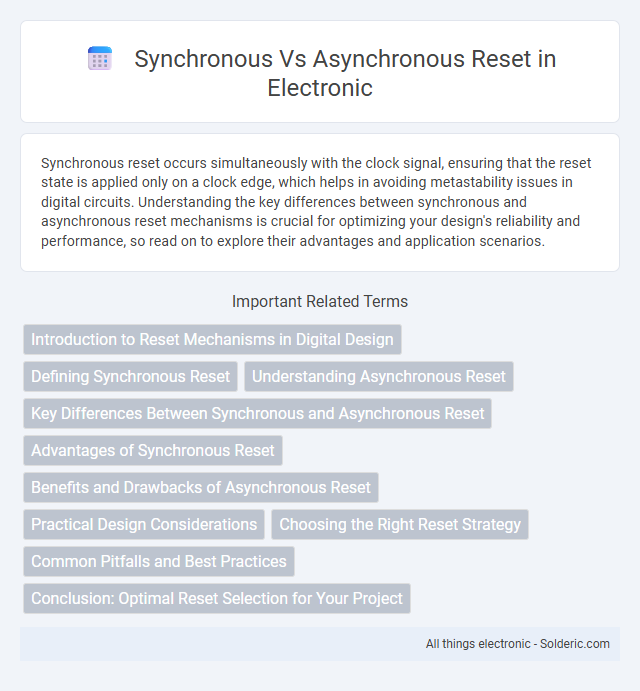Synchronous reset occurs simultaneously with the clock signal, ensuring that the reset state is applied only on a clock edge, which helps in avoiding metastability issues in digital circuits. Understanding the key differences between synchronous and asynchronous reset mechanisms is crucial for optimizing your design's reliability and performance, so read on to explore their advantages and application scenarios.
Comparison Table
| Feature | Synchronous Reset | Asynchronous Reset |
|---|---|---|
| Trigger Timing | Reset occurs on the clock edge | Reset occurs immediately, independent of clock |
| Design Complexity | Simpler timing analysis | Requires careful handling to avoid metastability |
| Glitch Sensitivity | Less sensitive to glitches | More prone to reset glitches |
| Metastability Risk | Lower risk due to clock synchronization | Higher risk; requires synchronization circuits |
| Reset Assertion | Only effective on clock edge | Effective immediately upon assertion |
| Use Case | Preferred for synchronous designs needing predictable timing | Common in systems requiring immediate reset response |
Introduction to Reset Mechanisms in Digital Design
Reset mechanisms in digital design serve to initialize circuits to a known state, ensuring predictable behavior at startup or during fault conditions. Synchronous reset asserts the reset signal in sync with the clock, guaranteeing alignment with clock edges and avoiding metastability, while asynchronous reset can assert at any time, providing immediate response but requiring careful handling to prevent timing issues. Designers choose between these resets based on timing requirements, complexity, and reliability needs of the digital system.
Defining Synchronous Reset
Synchronous reset is a type of reset signal in digital circuits that only activates the reset function in sync with the clock edge, ensuring that the reset state is applied during a specific clock cycle. This method aligns the reset operation with the clock, minimizing timing issues and glitches that might occur in asynchronous resets. Your design benefits from predictable timing behavior with synchronous reset, enhancing overall circuit stability.
Understanding Asynchronous Reset
Asynchronous reset instantaneously forces your digital circuit into a known state regardless of the clock signal, providing immediate control during power-up or fault conditions. This type of reset operates independently of the clock, allowing faster response time but may introduce metastability issues if not properly synchronized during release. Understanding asynchronous reset is crucial for designing reliable and predictable digital systems, especially in environments requiring rapid and unconditional reset behavior.
Key Differences Between Synchronous and Asynchronous Reset
Synchronous reset activates only during the clock edge, ensuring all flip-flops reset in alignment with the clock signal, which prevents timing issues but may increase the critical path delay. Asynchronous reset triggers immediately upon assertion, regardless of the clock, allowing rapid initialization but requiring careful design to avoid metastability and glitches. The choice between synchronous and asynchronous reset impacts timing closure, design complexity, and reliability in FPGA and ASIC circuits.
Advantages of Synchronous Reset
Synchronous reset ensures the reset signal is aligned with the clock, preventing glitches and metastability issues commonly found in asynchronous resets. It simplifies timing analysis and synthesis, improving overall design reliability and meeting setup and hold time requirements effectively. Your circuit benefits from predictable behavior during reset, leading to easier debugging and stable operation in synchronous digital systems.
Benefits and Drawbacks of Asynchronous Reset
Asynchronous reset offers the benefit of quickly bringing a digital circuit to a known state independent of the clock, which is crucial during power-up or emergency conditions. However, it can cause metastability and timing issues because the reset deassertion may occur asynchronously, leading to unpredictable behavior in flip-flops. You should weigh these benefits against the risk of glitches and design complexity when choosing asynchronous reset for your system.
Practical Design Considerations
Synchronous reset aligns the reset signal with the clock, ensuring predictable timing and easier integration within sequential logic but may increase critical path delays. Asynchronous reset provides immediate response independent of the clock, enhancing reliability during power-up or fault conditions, yet it requires careful handling to avoid metastability and glitches. Your choice depends on system requirements for timing precision, power-on behavior, and complexity of the reset distribution network.
Choosing the Right Reset Strategy
Choosing the right reset strategy depends on the specific timing requirements and design complexity of your digital circuit. Synchronous resets align with the clock, ensuring predictable timing and easier timing analysis, but may introduce delay in system initialization. Asynchronous resets provide immediate system-wide reset regardless of the clock, ideal for critical error recovery, but require careful design to avoid metastability and glitches during reset deassertion.
Common Pitfalls and Best Practices
Synchronous reset can cause timing issues if the reset signal is not properly aligned with the clock, leading to metastability and unpredictable behavior in your digital designs. Asynchronous reset, while ensuring immediate response, risks creating glitches and requires careful synchronization to avoid reset release hazards. Best practices include using asynchronous reset only for critical initialization, synchronizing its release to the clock domain, and preferring synchronous reset for consistent timing analysis and robust state retention.
Conclusion: Optimal Reset Selection for Your Project
Choosing between synchronous and asynchronous reset depends on your project's timing requirements and complexity. Synchronous resets offer synchronized state changes with the clock, minimizing metastability risks, while asynchronous resets provide immediate response but may introduce timing uncertainties. Evaluating your design constraints ensures the optimal reset type enhances reliability and performance.
synchronous vs asynchronous reset Infographic

 solderic.com
solderic.com